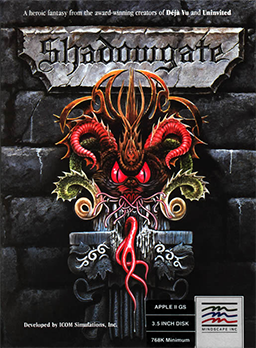Shadowgate
| Shadowgate | |
|---|---|
 Shadowgate box art | |
| Developer(s) | ICOM Simulations, Inc. |
| Publisher(s) | MindScape (Computer) Kemco (NES) |
| Series | Shadowgate, MacVenture |
| Engine | MacVenture |
| Platform(s) | Apple IIGS Commodore Amiga CD-i Game Boy Color Apple Macintosh Nintendo Entertainment System Palm OS DOS PocketPC (ARM/MIPS) Mobile Phone |
| Release | 1987 (Mac & Amiga) 1988 (PC) 1989 (NES) 1999 (GBC) 2002 (PocketPC) |
| Genre(s) | Adventure game |
| Mode(s) | Single player |
Shadowgate is a 1987 "point-and-click" adventure video game originally for the Mac and is the most popular in the MacVenture series. It was also released in 1989 for the Nintendo Entertainment System, where it garnered mild success. The game is named for its setting, Castle Shadowgate, residence of the evil Warlock Lord. The player, as the "last of a great line of hero-kings" is charged with the task of saving the world by defeating the Warlock Lord, who is attempting to summon up the demon Behemoth out of Hell.
Gameplay
The player must solve a series of puzzles throughout the castle in order to proceed to the Warlock Lord's chamber. Due to the castle's perilous nature, at least one lit torch must be in the player's possession at all times; if the torch is extinguished, the player soon stumbles, breaking his neck, and he must then continue from a saved game (or the area in which they died, in game console versions). Since there is only a finite number of torches to be found throughout the game, this effectively acts as a time limit to proceedings. Various items that can be acquired include sword, sling shot and other ancient weapons; though these weapons can not actually be used as striking weapons, they can be clicked on at the appropriate time to deliver a fatal blow to specific enemies
The game is notorious for its many opportunities of death, including being burned by a dragon's breath, attacked by a cyclops, sucked into outer space through a broken mirror, dissolved by acidic slime, mauled by a wolf-woman, eaten by sharks, and suicide. In fact, virtually any action taken by the player which is not the correct solution to a puzzle will result in a fatality. These deaths were often graphically described in the game's text (along with often sardonic and humorous comments), even in the NES version (in spite of Nintendo's policy of censorship at the time). Many of the game's puzzles rely on a system of trial and error, the problem of which is overcome by the ability to save the game state (as in most adventure games). Subtle hints can be found in books and the descriptive game texts. In the NES version, these are replaced by an outright hint feature which gives vague clues about what is noteworthy in any given room in the castle. The further the player progresses, however, the more useless this feature becomes, deteriorating into nothing but encouraging messages by the game's end. The NES version of Shadowgate also carries the distinction of being one of the few NES games to be available in a Swedish language version.
At the end of the game, the Warlock Lord has succeeded in opening the gates of Hell and summoning up the Behemoth. But with a holy artifact called the Staff of Ages, the player is able to mortally wound the demon; as it dies, the Behemoth drags the Warlock Lord with him into Hell. The player returns victorious to his kingdom, where he is betrothed to the king's daughter and entitled High Lord of the Westland.
Reception
Computer Gaming World gave the game a very positive review, noting the game uses the same superior interface as previous MacVenture games. The difficulty was noted as a step up from Deja Vu and Uninvited, but Shadowgate was also said to be more flexible, allowing more than one solution to some puzzles.[1]
The Swedish language version was noted because the "Hit" and "Leave" abilities was mistranslated into "Gä" and "Slä", instead of "Gå" and "Slå" which is the correct translation. Bergsala included an letter, apologizing it.
Sequels
There have been several sequels to the original Shadowgate on other platforms, such as Beyond Shadowgate on TurboGrafx 16 and Shadowgate 64: Trials of the Four Towers on the Nintendo 64. Another N64 sequel, Shadowgate Rising, was planned and well into development, but the project was scrapped when Nintendo announced the creation of the game console which would go on to become the GameCube, and it now only exists in the form of a handful of development screenshots and a comic on Infinite Ventures' website entitled Shadowgate Saga: Raven. A remake of the original ("Shadowgate Classic") was released for Windows and the handheld Pocket PC and Game Boy Color systems by Infinite Ventures.
The success of Shadowgate prompted ICOM Simulations to have Kemco/Seika port the other MacVenture titles to the Nintendo Entertainment System.
In the NES version of Uninvited, a phonograph in the Game room (Rec room in original versions) plays a broken-record version of the main theme from Shadowgate.
When the flute item is used in Shadowgate, it plays the first measure of the first song heard when gameplay commences in "Deja Vu".
Prequel story
- Before Shadowgate
A book published by Scholastic Corporation under the pen name 'F.X. Nine' was released in 1991 as part of the Worlds of Power series of Video Game Novelizations of third party Nintendo Entertainment System games.
References
- ^ Hines, Tracie Forman (November 1987), "Shadowgate: Inside the Castle Shadowgate", Computer Gaming World, pp. 41, 57
{{citation}}: CS1 maint: date and year (link)
